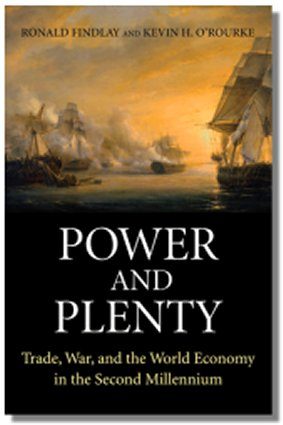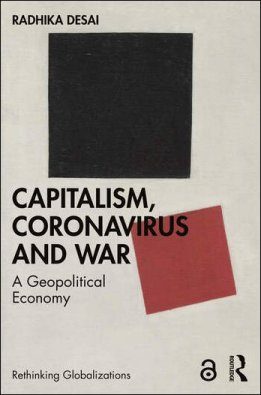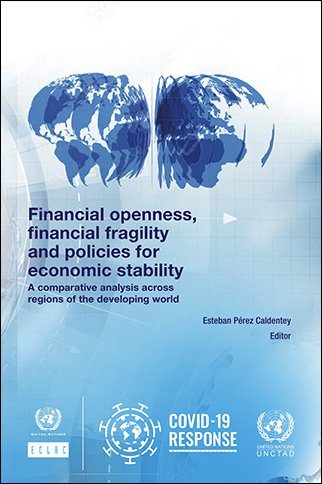Publisher: Third World Network Year: 2023 No. of pages: 42 Download now About the Book…
Power and Plenty: Trade, War, and the World Economy in the Second Millennium Author: Ronald Findlay and Kevin H. O'Rourke (Review by Erik S. Reinert)

Publisher: Princeton University Press
ISBN: -978-0-691-11854-3
Review by Erik S. Reinert
This book’s preface starts prosaically: ‘you cannot make sense of today’s world economy, or indeed of the world more generally, without understanding the history that produced it’, a history characterized by what the authors define as ‘uneven economic development’. More specifically, the authors seek to expose the relationship between the gradual globalization of the world economy on the one hand and economic and political development on the other during the second millennium of the common era (xvi). Their study divides the earth into several interacting ‘world regions’ and divides its history with three ‘great world-historical events’: the Black Death, the Columbian exchange, and the industrial revolution (xxi). As a world history spanning a millennium, it seeks to ‘avoid both the Scylla of Eurocentrism and the Charybdis of Sinocentrism’ (xviii), harnessing an impressive amount of secondary scholarship to do so. Their intimate familiarity with select traditions of modern historiography certainly makes for a unique and valuable survey of economic history, but the jarring paucity-if not complete absence-of primary sources and research will put off many historians. The authors are, however, commendably honest about this: ‘There is a lot in this book… that will be entirely unremarkable to any moderately well trained historian’ (xxvi). In effect, the great genius of their enterprise lies precisely in rendering a long and tumultuous period of human history readable for economists, and for this they deserve praise. But unfortunately the book fails to confront economic theory where it is at its weakest in terms of explaining the wealth and poverty of nations.
In this context, the book’s title is not incidental, for this is not yet another celebratory history of doux commerce. Contrary to the impression given by many economics textbooks, the authors argue, ‘the greatest expansions of world trade have tended to come not from the bloodless tâtonnement of some fictional Walrasian auctioneer but from the barrel of a Maxim gun, the edge of a scimitar, or the ferocity of nomadic horsemen’ (xviii). So while economists all too often neglect the violent complexities of economic history, Findlay and O’Rourke actively aimed to structure their history around a dichotomy lionized by the famous debate between Jacob Viner and Eli Heckscher over whether early modern states pursued power or plenty (197, 228, 261, 310, 361, passim). Historically, the authors clarify, the relation between power and plenty was such that ‘achieving either aim would promote further achievement of the other’ (191). That said, the authors are not afraid of applying the vocabulary and methodological assumptions of mainstream economics to the historical record. A ‘long-run equilibrium of sorts’, we learn, was established between the Mamluk successors of Saladin and the sultans of Yemen (99). And while a ‘general equilibrium model’ can explain the consequences of the Black Death (117), their explanation of the Industrial Revolution rests on a ‘benchmark neoclassical growth model’ (317). In short, ‘simple neoclassical predictions’ often do the trick (112).
It is quite a ride that Findlay and O’Rourke take their readers on, their book nimbly structured and invigorated by memorable episodes from the dustbins of economic history. We are introduced to the pan-continental economic benefits of ‘Viking degradations’ (85-86); to the consequences of the ‘Pax Mongolica’; the Florentine Francesco di Balducci Pegolotti’s remarkable statement in the early 1340s that travel by land from Crimea to Beijing was ‘perfectly safe, whether by day or by night’ (107); and even the Sultan Iskander Muda’s ‘monster galley’, the most massive wooden vessel in history, named ‘the terror of the universe’, which notably failed to stand up against Portuguese aggressors in Southeast Asia (201). As a history of world trade in the last millennium, the book at hand is in effect a violent history of ‘globalization’, conceptualized, however, teleologically as the gradual release of economic forces from the shackles of natural and political barriers. Hence the prevalence of phrases such as ‘Once Britain had finally switched to free trade…’ (377). This proclivity is symptomatic of an unfortunate tension running throughout the book. It is as if we are led to believe that England’s biggest historical mistake was when, under the Tudors, the nation stopped specializing according to its comparative advantage of being a poor supplier of raw wool for the textile producing hubs of the continent and embarked on a centuries-long strategy of emulating those same manufacturing hubs through an arsenal of policies which included armed aggression and heavy-handed protectionism. Adam Smith, for one, saw the immense historical importance of putting the Navigation Acts before free trade.
On the one hand, we are repeatedly shown how conquests, tariffs, and state interventions were extraordinarily effective in creating wealth for the first world from the end of the Renaissance to the nineteenth century (210, 301, 309, 325, 345, 423). On the other, the authors’ commitment to Samuelsonian economics leads them to downright procrustean readings. So we learn that the Fatamids followed ‘generally enlightened policies’ which can be described ‘as being of an almost laissez-faire character’ (57), and the Opium Wars are unproblematically described as resulting in ‘freer trading conditions’ (388). They speak of the ‘stark division of labour between a manufacturing core and a primary-producing periphery’ (xx), yet they seemingly lament, discussing Communism, that ‘by promoting the development of heavy industry, the Soviet system led to the breakdown of the traditional European division of labor, which had seen a largely agricultural Eastern Europe exporting agricultural products to Western Europe, in exchange for industrial goods’ (478). Are we to believe the Russians would have been better off supplying Europe with grain, or perhaps as indentured servants of the Czar? It would seem so, since the authors also argue Prebish and Singer ‘mistakenly projected’ the ‘collapse’ of ‘terms of trade’ during the interwar period ‘both backwards and forwards in time, and argued that specialization in primary products was harmful for developing countries’ (484). Were they and are they not? Was Laos like England in the nineteenth century? Is Mongolia like the United States today?
When the authors arrive at what is probably the most important lesson of economic history – that of the different mechanisms set in motion by increasing returns and a large division of labour on the one hand and diminishing returns and monoculture on the other – they back off from facing the unequivocal burden of proof from 500 years of economic history. For all their work on industrial development, the authors retrench into the safety of what Buchanan calls ‘the equality assumption’ – that all economic activities are qualitatively alike – and consequently into the safe haven of basic neo-classical trade theory. Here Findlay and O’Rourke follow the example of Paul Krugman. Based on a 1923 article by Frank Graham – a simple model showing how nations specializing in diminishing returns activities grow poorer under international trade – the early Krugman told his readers how Lenin and the classical development economists were right. However, ‘effective demand’ in academic economics soon led Krugman to disregard the effects of diminishing returns, that were so important to English classical economists from Malthus to Mill, and concentrate on increasing returns under the ‘equality assumption’. Findlay and O’Rourke also in the end disregard the theoretical implications of a mass of historical evidence contradicting the wisdom of today’s world economic order. The way the authors teasingly approach the conclusion of the importance of increasing and diminishing returns – of manufacturing and advanced services vs. raw materials – and then back off just before reaching the conclusion, is an interesting study in itself. Very sadly this reviewer’s associations automatically wandered off to consider the brinkmanship that academic writers have had to confront with censors from time immemorial to the East German ‘Jahrbuch für Wirtschaftsgeschichte’ (Annals of Economic History), a publication that – when similarly stripped of mandatory ideological chaff – actually contained much good work on economic history.
Immense work has obviously gone into this book, and the result is truly an extraordinary synthesis of economic history. Yet, and particularly given what the events of the past year have demonstrated, the authors’ rigorous and hubristic theoretical underpinnings hurt their endeavour deeply, and a more humble approach to the past would certainly have been in order. For, these days, it is hard to know what to make of their argument, based on Dani Rodrik, that while ‘the World Bank and IMF’ perhaps ‘used the leverage which developing countries’ debt problems gave them to push for trade reforms as well as macroeconomic reforms’, this ‘can hardly have mattered in the cases of economic and political giants such as Argentina’ (498). An extraordinarily counterfactual statement. Another irony is that Findlay and O’Rourke present what England did for centuries as ‘mercantilism’, while we are told ‘in Taiwan, liberalization started in 1958, when the government started replacing quantitative restrictions on trade with tariffs, lowering the costs of imported raw materials, and encouraging exports’. This is of course precisely what England and other successful nations had done for centuries. That Findlay and O’Rourke call such measures mercantilism in one case and liberalization in the other is deeply problematic, and a telling indication of the book’s underlying schizophrenia in seeking to unite the cruel reality of the historical record with utopian theories of market-made economic harmony.
No doubt, students and scholars will benefit immensely from this book, and hopefully they can do so without downing it hook, line, and sinker. For, their theoretical prejudices aside, many of Findlay and O’Rourke’s historical instincts are healthy, as is evident from one of their timeless observations: ‘globalization led to losers as well as winners’ (410). But where is the economic theory that backs this statement up? The contingency of development, the complexities of power and plenty, these are the lessons which students and scholars should take home from this history, not the parodic triumphalism to which the book sadly clings.
Erik S. Reinert, University of Technology, Estonia, and The Other Canon Foundation, Norway. Email: eriksreinert@gmail.com.



